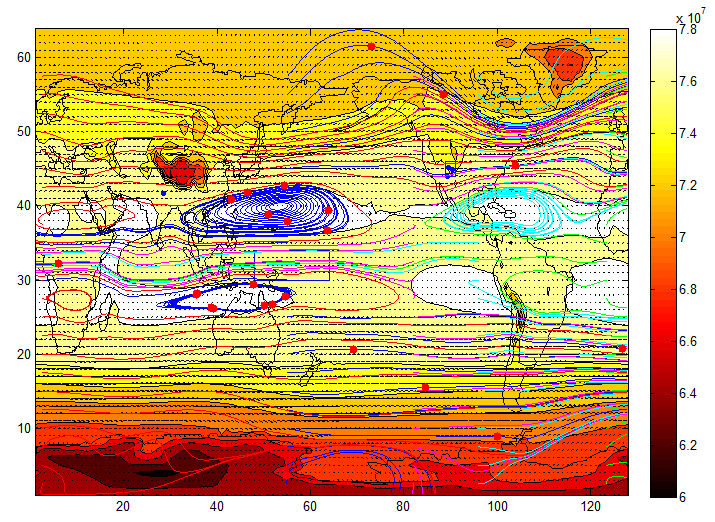This featured animation shows the result of my releasing 2 dozen neutrally bouyant particles into the global geostrophic slipstream along 157.5 degrees longitude East (for the most part in this rough around the edges Matlab code). The indexes on the left and bottom axes reflect redistributing the ERA Interim values to a coarser grid from their original 256 by 512 dimensions. The contours shown are geopotential height Z. The geostrophic wind vectors are from ERA Interim U and V sets for zonal and meridional integrated atm. wind velocity respectively. The green streamlines originate from just west of the Greenwich Meridian (at right end of this map). The blue streamlines originate from 157.5 E (the same as for the particles nominally). The red streamlines start just east of the Greenwich Meridian (left end of map).
The time span applied is for the average condition from 1979 through 2014. It appears to capture some of the geostrophic flow features of greatest current interest to me. For example, the basic zonal and meridional flow patterns are consistent with basic Hadley and Walker circulation concepts. For a good example of this in comparison to basic synoptic weather, see this post on those flows and the Polar Vortex of 2014.
If the geostrophic flow patterns predominate over time and on the scale shown, then much can be applied to solar forecasting. For my forecasting which recognizes solar inputs as key, the rates as well as the residence times of air parcel circulation (the so called atmospheric conveyor belt) are crucial.
The rest is only for the geekiest!
I conducted a first order draft calculation of the outer and inner particles of the west pacific north equatorial gyre animation featured. The inner particles have a much greater angular velocity than the outer particles, which is at least consistent with the conservation of momentum principal. A back of the envelope calculation assuming 20 revolutions around the gyre before exiting, suggests that gyre captured residence times of 5 to 10 years of air parcels might not be exceptional. That’s also not unusual to find in literature citations.
 6245total visits,3visits today
6245total visits,3visits today
